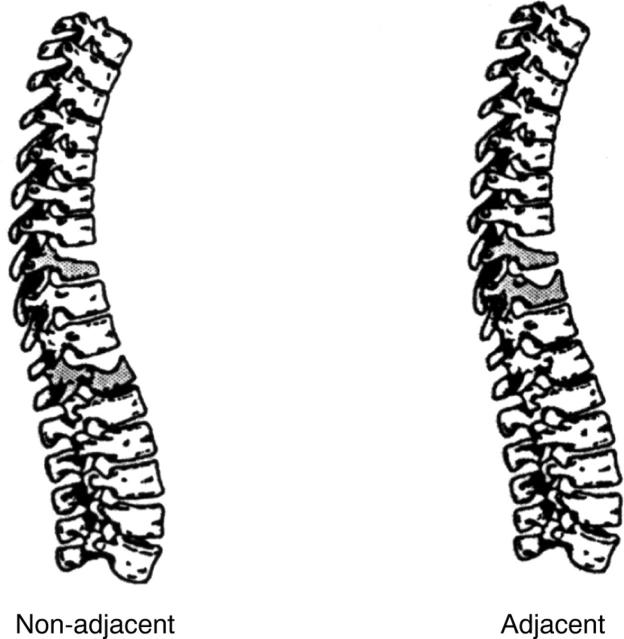Abstract
OBJECTIVE—Vertebral deformity is associated with back pain and disability. The aim of this analysis was to determine whether location within the spine influences the strength of association between vertebral deformity, back pain and disability. METHODS—Men and women aged 50 years and over were recruited from population registers in 30 European centres. Subjects were invited for an interviewer administered questionnaire, and for lateral spinal radiographs. The questionnaire included questions about back pain, general health and functional ability. The spinal radiographs were evaluated morphometrically and vertebral deformity defined according to the McCloskey-Kanis method. RESULTS—756 (11.7%) men and 885 (11.8%) women had evidence of one or more vertebral deformities. Among women with a single deformity, after adjusting for age and centre, those with a lumbar deformity were more likely than those with a thoracic deformity to report back pain, both currently (OR=1.4; 95% CI 1.0, 2.0) and in the past year (OR=1.5; 95% CI 1.0, 2.3). No association was observed in men. Among women with two deformities, those with adjacent deformities were more likely than those with non-adjacent deformities to report poor general health (OR=2.2; 95%CI 0.9, 5.6), impaired functional ability (OR=1.9; 95%CI 0.8, 4.7) and current back pain (OR=2.1; 95%CI 0.9, 4.9), though none of these associations were statistically significant. By contrast, among men, non-adjacent deformities were associated with impaired functional ability compared with those with adjacent deformities. CONCLUSION—Location within the spine influences the strength of association between self reported health factors and vertebral deformity.
Full Text
The Full Text of this article is available as a PDF (140.0 KB).
Figure 1 .
Adjacent and non-adjacent vertebral deformities.
Selected References
These references are in PubMed. This may not be the complete list of references from this article.
- Burger H., Van Daele P. L., Grashuis K., Hofman A., Grobbee D. E., Schütte H. E., Birkenhäger J. C., Pols H. A. Vertebral deformities and functional impairment in men and women. J Bone Miner Res. 1997 Jan;12(1):152–157. doi: 10.1359/jbmr.1997.12.1.152. [DOI] [PubMed] [Google Scholar]
- Cooper C., Atkinson E. J., O'Fallon W. M., Melton L. J., 3rd Incidence of clinically diagnosed vertebral fractures: a population-based study in Rochester, Minnesota, 1985-1989. J Bone Miner Res. 1992 Feb;7(2):221–227. doi: 10.1002/jbmr.5650070214. [DOI] [PubMed] [Google Scholar]
- Ettinger B., Black D. M., Nevitt M. C., Rundle A. C., Cauley J. A., Cummings S. R., Genant H. K. Contribution of vertebral deformities to chronic back pain and disability. The Study of Osteoporotic Fractures Research Group. J Bone Miner Res. 1992 Apr;7(4):449–456. doi: 10.1002/jbmr.5650070413. [DOI] [PubMed] [Google Scholar]
- Huang C., Ross P. D., Wasnich R. D. Vertebral fractures and other predictors of back pain among older women. J Bone Miner Res. 1996 Jul;11(7):1026–1032. doi: 10.1002/jbmr.5650110721. [DOI] [PubMed] [Google Scholar]
- Jochheim K. A. Prof. Dr. med. K.-A. Jochheim, Promotor der Rehabilitation--ein Interview. Rehabilitation (Stuttg) 1996 Feb;35(1):1–5. [PubMed] [Google Scholar]
- Leidig G., Minne H. W., Sauer P., Wüster C., Wüster J., Lojen M., Raue F., Ziegler R. A study of complaints and their relation to vertebral destruction in patients with osteoporosis. Bone Miner. 1990 Mar;8(3):217–229. doi: 10.1016/0169-6009(90)90107-q. [DOI] [PubMed] [Google Scholar]
- Lyles K. W., Gold D. T., Shipp K. M., Pieper C. F., Martinez S., Mulhausen P. L. Association of osteoporotic vertebral compression fractures with impaired functional status. Am J Med. 1993 Jun;94(6):595–601. doi: 10.1016/0002-9343(93)90210-g. [DOI] [PubMed] [Google Scholar]
- Matthis C., Weber U., O'Neill T. W., Raspe H. Health impact associated with vertebral deformities: results from the European Vertebral Osteoporosis Study (EVOS). Osteoporos Int. 1998;8(4):364–372. doi: 10.1007/s001980050076. [DOI] [PubMed] [Google Scholar]
- McCloskey E. V., Spector T. D., Eyres K. S., Fern E. D., O'Rourke N., Vasikaran S., Kanis J. A. The assessment of vertebral deformity: a method for use in population studies and clinical trials. Osteoporos Int. 1993 May;3(3):138–147. doi: 10.1007/BF01623275. [DOI] [PubMed] [Google Scholar]
- O'Neill T. W., Cooper C., Cannata J. B., Diaz Lopez J. B., Hoszowski K., Johnell O., Lorenc R. S., Nilsson B., Raspe H., Stewart O. Reproducibility of a questionnaire on risk factors for osteoporosis in a multicentre prevalence survey: the European Vertebral Osteoporosis Study. Int J Epidemiol. 1994 Jun;23(3):559–565. doi: 10.1093/ije/23.3.559. [DOI] [PubMed] [Google Scholar]
- O'Neill T. W., Felsenberg D., Varlow J., Cooper C., Kanis J. A., Silman A. J. The prevalence of vertebral deformity in european men and women: the European Vertebral Osteoporosis Study. J Bone Miner Res. 1996 Jul;11(7):1010–1018. doi: 10.1002/jbmr.5650110719. [DOI] [PubMed] [Google Scholar]
- Ryan P. J., Blake G., Herd R., Fogelman I. A clinical profile of back pain and disability in patients with spinal osteoporosis. Bone. 1994 Jan-Feb;15(1):27–30. doi: 10.1016/8756-3282(94)90887-7. [DOI] [PubMed] [Google Scholar]
- Ryan P. J., Evans P., Gibson T., Fogelman I. Osteoporosis and chronic back pain: a study with single-photon emission computed tomography bone scintigraphy. J Bone Miner Res. 1992 Dec;7(12):1455–1460. doi: 10.1002/jbmr.5650071213. [DOI] [PubMed] [Google Scholar]



